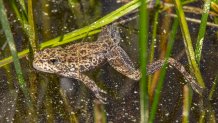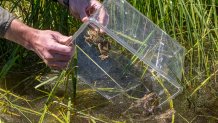Scientists from the San Diego Zoo Wildlife Alliance and Omaha's Henry Doorly Zoo and Aquarium reintroduced more than 70 endangered mountain yellow-legged frogs into a lake located in the San Bernardino Mountains, it was announced Tuesday.
This release marks the first time the Southern California distinct population segment of the mountain yellow-legged frog has been reintroduced into a lake instead of a mountain stream, a statement from the wildlife alliance read.
The frogs were bred at the San Diego Zoo Wildlife Alliance's Beckman Center for Conservation Research between 2020 and 2022, and then reared at the Omaha zoo.
"We have the unique ability to act as a remote head-start facility for the conservation recovery team and are committed to helping conserve these frogs," said Derek Benson, amphibian conservation researcher and lead keeper at the Henry Doorly Zoo & Aquarium. "We are thrilled to be part of the return of these animals to a historic site as the population rebounds."
Get San Diego local news, weather forecasts, sports and lifestyle stories to your inbox. Sign up for NBC San Diego newsletters.
Classified as endangered, severe population fragmentation has led to estimates of fewer than 200 adult mountain yellow-legged frogs remaining in their native habitats. The mountain yellow-legged frog is facing many threats to its survival, including disease, introduced predators, wildfires and drought driven by climate change, a SDZWA statement reads.

According to the organizations, the frogs were released in two cohorts. The first group arrived from Omaha on the day of their release and were placed in a protective habitat at the lake for seven days, so they could adjust to their new surroundings. The team performed daily health checks on the frogs and fed them a variety of insects, including those collected from their environment.
The second cohort arrived the following week and were released into the lake alongside the initial group. Researchers are evaluating the release techniques, along with several other factors, to better understand which combination of reintroduction strategies will prove most beneficial for the species' survival.

"Lakes have the advantage of more permanent water that is less likely to dry up in a drought," said Debra Shier, associate director of recovery ecology at SDZWA.
Local
"When water habitats like streams do begin to lose water, adult frogs may be able to move, but tadpoles can't. It's important that we're identifying and preserving suitable habitats in the mountain yellow-legged frogs' native range that can hopefully prove hospitable for this species for years to come -- despite the increasing pressures brought on by climate change."
To date, San Diego Zoo Wildlife Alliance has bred and reintroduced thousands of individuals back into high-elevation mountain habitats and monitored their success.



